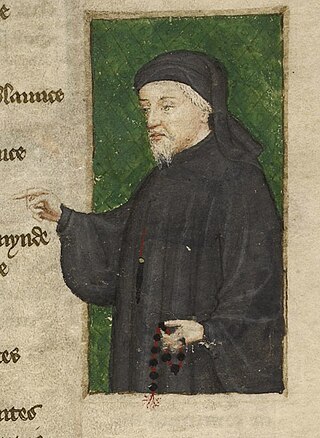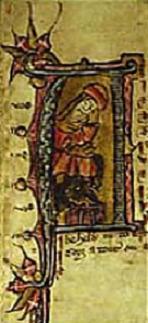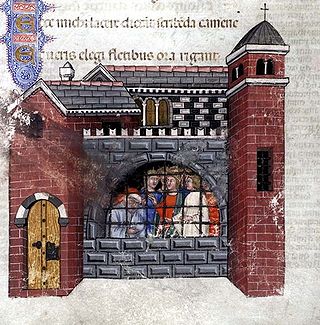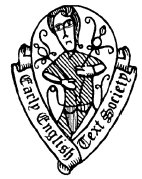Related Research Articles

Geoffrey Chaucer was an English poet, author, and civil servant best known for The Canterbury Tales. He has been called the "father of English literature", or, alternatively, the "father of English poetry". He was the first writer to be buried in what has since come to be called Poets' Corner, in Westminster Abbey. Chaucer also gained fame as a philosopher and astronomer, composing the scientific A Treatise on the Astrolabe for his 10-year-old son Lewis. He maintained a career in the civil service as a bureaucrat, courtier, diplomat, and member of parliament.

Piers Plowman or Visio Willelmi de Petro Ploughman is a Middle English allegorical narrative poem by William Langland. It is written in un-rhymed, alliterative verse divided into sections called passus.

In prosody, alliterative verse is a form of verse that uses alliteration as the principal device to indicate the underlying metrical structure, as opposed to other devices such as rhyme. The most commonly studied traditions of alliterative verse are those found in the oldest literature of the Germanic languages, where scholars use the term 'alliterative poetry' rather broadly to indicate a tradition which not only shares alliteration as its primary ornament but also certain metrical characteristics. The Old English epic Beowulf, as well as most other Old English poetry, the Old High German Muspilli, the Old Saxon Heliand, the Old Norse Poetic Edda, and many Middle English poems such as Piers Plowman, Sir Gawain and the Green Knight, Layamon's Brut and the Alliterative Morte Arthur all use alliterative verse.

William Langland is the presumed author of a work of Middle English alliterative verse generally known as Piers Plowman, an allegory with a complex variety of religious themes. The poem translated the language and concepts of the cloister into symbols and images that could be understood by a layman.
Cleanness is a Middle English alliterative poem written in the late 14th century. Its unknown author, designated the Pearl poet or Gawain poet, also appears, on the basis of dialect and stylistic evidence, to be the author of Sir Gawain and the Green Knight, Pearl, and Patience, and may have also composed St. Erkenwald.
Pierce the Ploughman's Crede is a medieval alliterative poem of 855 lines, lampooning the four orders of friars.

A dream vision or visio is a literary device in which a dream or vision is recounted as having revealed knowledge or a truth that is not available to the dreamer or visionary in a normal waking state. While dreams occur frequently throughout the history of literature, visionary literature as a genre began to flourish suddenly, and is especially characteristic in early medieval Europe. In both its ancient and medieval form, the dream vision is often felt to be of divine origin. The genre reemerged in the era of Romanticism, when dreams were regarded as creative gateways to imaginative possibilities beyond rational calculation.
There are two pseudo-Chaucerian texts called "The Plowman's Tale".
The Pilgrim's Tale is an English anti-monastic poem. It was probably written c. 1536–38, since it makes references to events in 1534 and 1536 – e.g. the Lincolnshire Rebellion – and borrows from The Plowman's Tale and the 1532 text by William Thynne of Chaucer's Romaunt of the Rose, which is cited by page and line. It remains the most mysterious of the pseudo-Chaucerian texts. In his 1602 edition of the Works of Chaucer, Thomas Speght mentions that he hoped to find this elusive text. A prefatory advertisement to the reader in the 1687 edition of the Works speaks of an exhaustive search for The Pilgrim's Tale, which had proved fruitless
The Piers Plowman tradition is made up of about 14 different poetic and prose works from about the time of John Ball and the Peasants Revolt of 1381 through the reign of Elizabeth I and beyond. All the works feature one or more characters, typically Piers, from William Langland's poem Piers Plowman. Because the Plowman appears in the General Prologue to The Canterbury Tales by Geoffrey Chaucer but does not have his own tale, plowman tales are sometimes used as additions to The Canterbury Tales, or otherwise conflated or associated with Chaucer.
The Praier and Complaynte of the Ploweman unto Christe: written not longe after the yere of our Lorde. M. and three hundred is a short, anonymous English Christian text, probably written in the late fourteenth or early fifteenth century and first printed in about 1531. It consists of a prose tract, in the form of a polemical prayer, expressing Lollard sentiments and arguing for religious reform. In it, the simple ploughman/narrator speaks on behalf of "the repressed common man imbued with the simple truths of the Bible and a knowledge of the commandments against the mighty and monolithic conservative church". The pastoral-ecclesiastical metaphor of shepherds and sheep is used extensively as a number of criticisms are made about such things as confession, indulgences, purgatory, tithing and celibacy. The Prayer became important in the sixteenth century, when its themes were taken up by proponents of the Protestant Reformation.

The Early English Text Society (EETS) is a text publication society founded in 1864 which is dedicated to the editing and publication of early English texts, especially those only available in manuscript. Most of its volumes contain editions of Middle English or Old English texts. It is known for being the first to print many important English manuscripts, including Cotton Nero A.x, which contains Pearl, Sir Gawain and the Green Knight, and other poems.
Richard the Redeless is an anonymous fifteenth-century English alliterative poem that critiques Richard II's kingship and his court, seeking to offer Richard retrospective advice, following his deposition by Henry IV in 1399. The poet claims that "Richard has been poorly advised, his kingdom mismanaged, his loyal subjects ill-served." The author believes that the advice he imparts will be of great aid to any guiding the kingdom in future years. The poem also contains elements of satire, especially towards court manners and clothing fashions.
John Audelay was an English priest and poet from Haughmond Abbey, in Shropshire; one of the few English poets of the period whose name is known to us. Some of the first Christmas carols recorded in English appear among his works.
Wynnere and Wastoure is a fragmentary Middle English poem written in alliterative verse around the middle of the 14th century.
The Alliterative Revival is a term adopted by literary historians to refer to the resurgence of poetry using the alliterative verse form in Middle English between c. 1350 and 1500. Alliterative verse was the traditional verse form of Old English poetry; the last known alliterative poem prior to the Revival was Layamon's Brut, which dates from around 1190.
The StanzaicMorte Arthur is an anonymous 14th-century Middle English poem in 3,969 lines, about the adulterous affair between Lancelot and Guinevere, and Lancelot's tragic dissension with King Arthur. The poem is usually called the Stanzaic Morte Arthur or Stanzaic Morte to distinguish it from another Middle English poem, the Alliterative Morte Arthure. It exercised enough influence on Thomas Malory's Le Morte d'Arthur to have, in the words of one recent scholar, "played a decisive though largely unacknowledged role in the way succeeding generations have read the Arthurian legend".
Helen Barr is an academic specialising in English literature on the late medieval period. She has spent her entire career at the University of Oxford, and, in 2016, the university awarded her the title of Professor of English Literature.
Thorlac Francis Samuel Turville-Petre is an English philologist who is Professor Emeritus and former head of the School of English at the University of Nottingham. He specializes in the study of Middle English literature.
Mabel Katharine Day was a British scholar of medieval English. She managed the Early English Text Society from 1921 to the 1940s as assistant director. She edited and published medieval texts including contributions to A Guide for Anchoresses and Sir Gawain and the Green Knight.
References
- Ousby (ed) Cambridge Companion to Literature in English (1993)
- ↑ Richard the Redeless and Mum and the Sothsegger, ed. James M. Dean, (Kalamazoo: TEAMS, 2000), p.83.
- ↑ Cambridge Companion to Literature in English, ed. Ian Ousby (CUP, 1993).
- ↑ Day, Mabel, and Robert Steele, eds. Mum and the Sothsegger Edited from the Manuscripts Camb. Univ. Ll. iv. 14 and Brit. Mus. Add 41666. EETS o.s. 199. (Oxford: OUP, 1936), p.xn3
- ↑ Day and Steele, Mum and the Sothsegger EETS (OUP, 1936), p. x.
- ↑ Richard the Redeless and Mum and the Sothsegger, ed. James M. Dean, (Kalamazoo: TEAMS, 2000), pp.77-8.